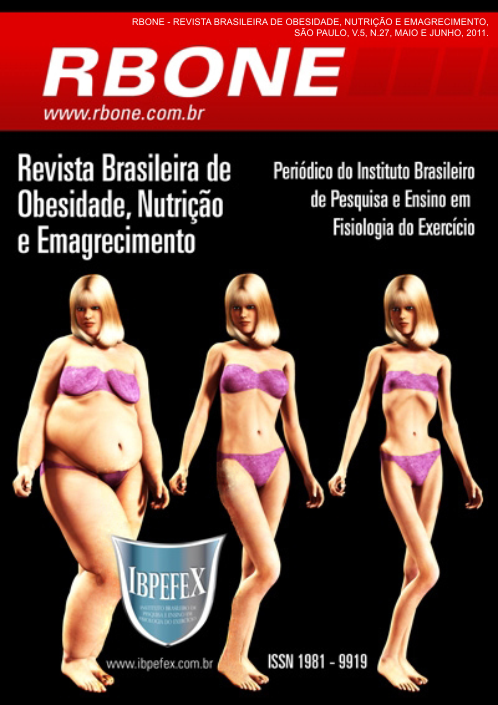Influence of low weigth overwight and obesity in quality of life of adolescents schools of the municipally of saintpaul
Abstract
The audience of this study was composed of 32 public school students in the region of Butantan São Paulo, aged between 11 and 15 years. We used two questionnaires: one to assess the quality of life called SF-36, another to analyze the quality and quantity of food suggested by the WHO. Also, was collected from other data such as age, weight, height sum of four skinfolds, adipometer, measuring tape, digital scale and physical evaluation software. The study concludes that body composition may cause changes in the psychological aspects of adolescents students and that these changes may influence the quality of life for them.
References
-Almeida Filho, N. Confiabilidade de um questionário para detecção de transtornos mentais na infância e adolescência. Rev Med Bahia. Vol. 23. p. 43-52. 1976.
-Almeida Filho, N. Development and assessment of the QMPI, a Brazilian children`s behavior questionnaire for completion by parents. Soc. Psychatry, Vol. 17. Núm. 3. p. 256-62, 1980. Caderno de Saúde Pública, Vol. 2. Núm. 3. p. 334-348. 1986.
-Bastos, A.C.; Almeida Filho, N. Variables econômico sociales, ambiente familiar y salud mental infantil emumaárea urbana de Salvador (Bahia) Brasil. Acta Psiquiátrica y Psicológica América Latina. Vol. 36. Núm. 3/4. p. 147-154. 1990.
-Battistone, M. M. M. Obesidade Feminina na Adolescência: Revisão Teórica e casos ilustrativos -Visão Psicossomática. Tese de Doutorado em Saúde Mental. Campinas. Unicamp. 1996.
-Bouchard, C. Genetics of obesity: overview and research direction. In: Bouchard C, E. The Genetics of Obesity. Boca Raton. p. 223-233. 1994.
-Benvegnu, L.A.; Fassa, A.G.; Facchini, L.A.; Wegman, D.H.; Dall’Agnol, M.M. Work and behavioural problems in children and adolescents. Int. J. Epidemiology. Vol. 34. p. 1417-1424. 2005.
-Dowda, M.; Ainsworth, B.E.; Addy, C.L.; Saunders, R.; Roner, W. Environmental influences, physical activity and weight status in 8-to 18-year-olds. Arch Pediatr Adolesc Med. Vol. 155. Núm. 6. p. 711-717. 2001.
-Epstein, L.H.; e colaboradores. Decreasing sedentary ehaviors in treating pediatric obesity. Arch Pediatr. Adolesc. Med. Vol. 154. p. 220-226. 2000.
-Fonseca, V.M.; Sichieri, R.; Veiga, G.V. Fatores associados à obesidade em adolescentes. Rev. Saúde Pública. Vol. 32. Núm. 6. p. 541-549. 1998.
-Gortmaker, S.L.; e colaboradores. Social and economic consequence of overweight in adolescence and young adulthood. N. Engl. J. Med. Vol. 329. p.1008-1012. 1993.
-A Pesquisa de Orçamentos Familiares IBGE 2002-2003. Estudo Nacional da Despesa Familiar -ENDEF, realizado pelo IBGE, em 1974-1975, e na Pesquisa Nacional sobre Saúde e Nutrição -PNSN, realizada pelo INAN em colaboração com o IPEA e o IBGE, em 1989.
-Hill, J.O.; Peters, J.C. Environmental contributions to the obesity epidemic. Science. Vol. 280. p. 1371-1374. 1998.
-Instituto Brasileiro de Geografia e Estatística. Pesquisa de orçamentos familiares: medidas antropométricas de crianças e adolescentes 2002-2003. Rio de Janeiro: IBGE. 2004.
-Levin, S.; Lowry, R.; Brown, D.R.; Dietz, W.H. Physical Activity and Body Mass Index Among US Adolescents: youth risk behanior survey, 1999. Arch Pediatr Adolesc Med. Vol. 157. Vol. 8. p. 816-820. 2003.
-Manios, Y.; Kolotourou, M.; Moschonis, G.; Sur, H.; Keskin, Y.; Kocaoglu, B.; Hayran, O. Macronutrient, physical activity, serum lipids and increased body weight in primary schoolchidren in Instanbul. Pediatr Int. Vol. 47. Núm. 2. p. 159-166. 2005.
-Monteiro, C.A.; Conde, W.L.; Popkin, B.M. Independent effects of income andeducation on the risk of obesity in the Brazilian adult population. Journal of Nutrition, Vol. 131. p. 881S-886S. 2001.
-Nunes, M.A.; Olinto, M.T.; Barros, F.C. Camey S. Influência da percepção do peso e do índice de massa corporal nos comportamentos alimentares anormais. Rev Bras Psiquiatr. Vol. 23. Núm. 1. p. 21-7. 2001.
-Paula, C.S.; Vedovato, M.S.; Bordin, I.A.S.; Barros, M.G.S.M.; D’Antino, M.E.F.; Mercadante, M.T. Mental health and violence among sixth grade students from a city in the state of São Paulo. Rev. Saúde Pública. Vol. 42. Núm. 3. p. 524-528. 2008.
-Price, R. Genetics and common obesities: background, corrent status, strategies, and future prospects. In: Wadden T, Tunkard AJ, eds. Handbook for Obesity Treatment. New York. Guilford Press. p. 73-94. 2002.
-Salvo, C.; Silvares, E.F.M.; Toni, P.M. Práticas educativas como forma de predição de problemas de comportamento e competência social. Estudos de Psicologia. Vol. 22. Núm. 2. p.187-195. 2005.
-Slade, P.D.; Body Image in anorexia nervosa. Br J Psychiatry Suppl. Vol. 2. p. 20-2. 1988.
-Vitolo, Y.L.; Fleitlich-Bilyk, B.; Goodman, R.; Bordin, I.A. Parental beliefs and child-rearing attitudes and mental health problems among schoolchildren. Rev. Saúde Pública. Vol. 39. p. 716-724. 2005.
-World Health Organization. Obesity: preventing and managing the global epidemic. Report of the WHO Consultation on Obesity. Geneva: WHO. 1998.
Authors who publish in this journal agree to the following terms:
- Authors retain the copyright and grant the journal the right of first publication, with work simultaneously licensed under the Creative Commons Attribution License BY-NC which allows the sharing of the work with acknowledgment of the authorship of the work and initial publication in this journal.
- Authors are authorized to enter into additional contracts separately for non-exclusive distribution of the version of the work published in this journal (eg, publishing in institutional repository or book chapter), with acknowledgment of authorship and initial publication in this journal.
- Authors are allowed and encouraged to post and distribute their work online (eg, in institutional repositories or on their personal page) at any point before or during the editorial process, as this can bring about productive change as well as increase impact and impact. citation of published work (See The Effect of Free Access).






